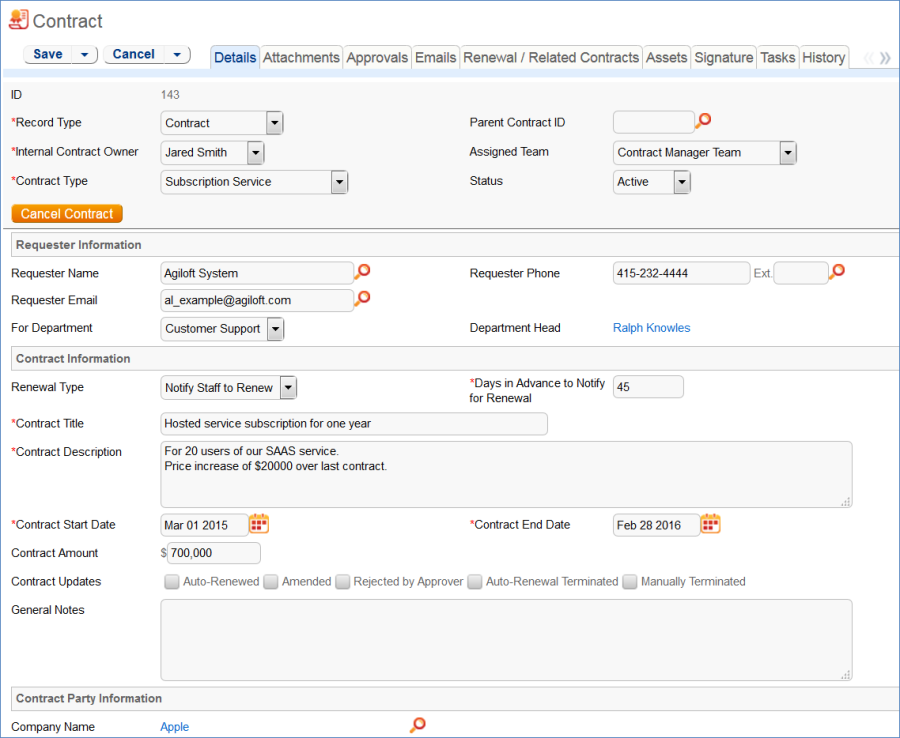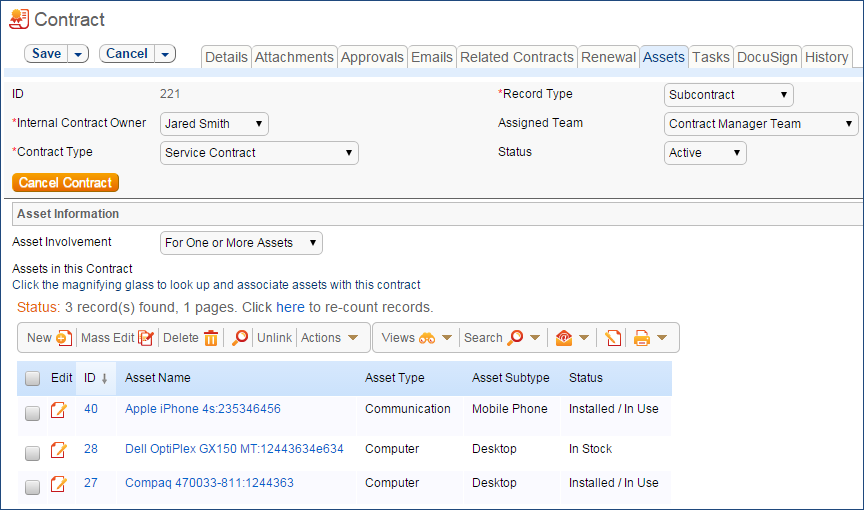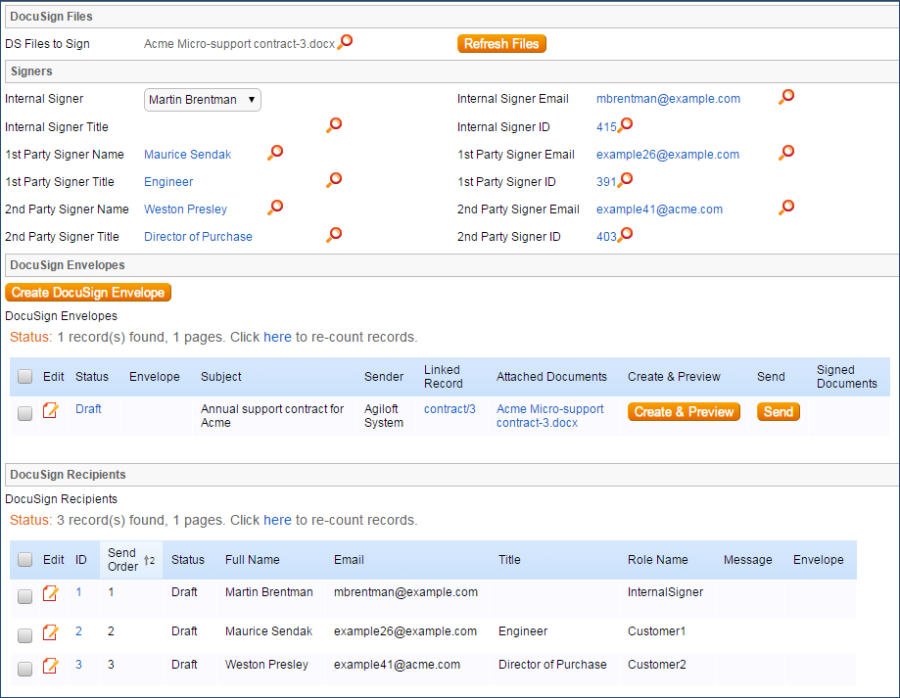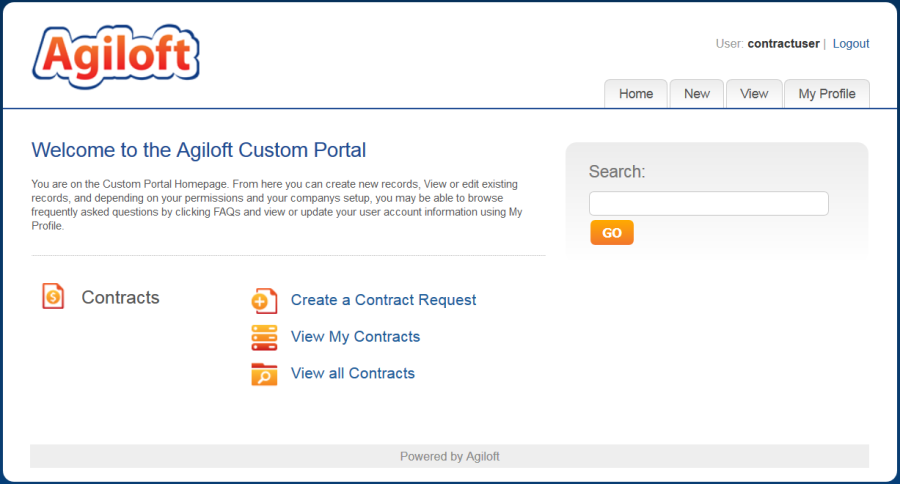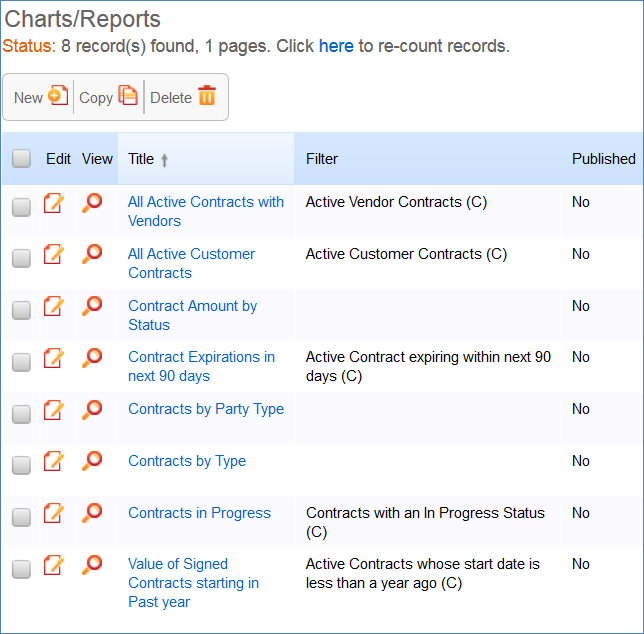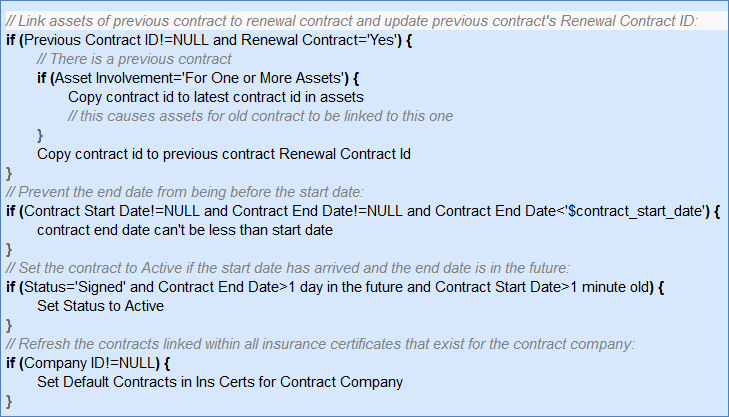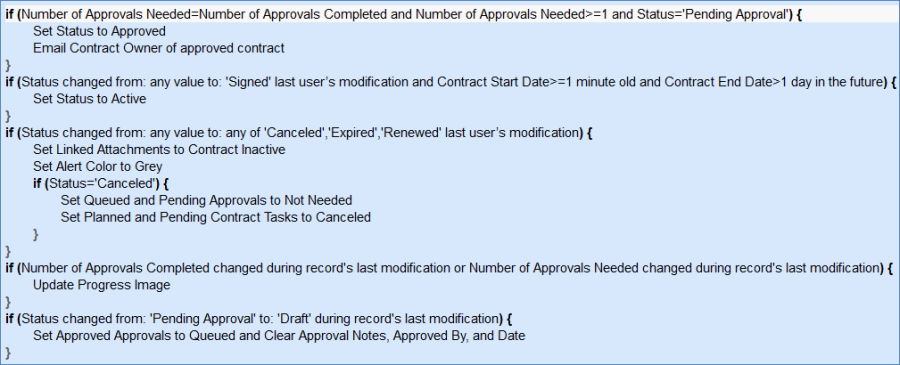The Contracts table holds all contract records. It also controls all associated automation and notifications related to contracts. A representative record is shown below.
Required fields, marked with a red asterisk, are: Record Type, Internal Contract Owner, Contract Type, Days in Advance to Notify for Renewal, Contract Title, Contract Description, Contract Start Date, and Contract End Date.
...
Once the appropriate fields are filled in, the contract may be saved in a Status of Draft.
The contract's Status field is changed automatically by the system at appropriate points in the workflow, generally when an action button is pressed or when some condition is met; however, users in the Admin group can manually override the Status if necessary.
Information about the contract requester, external company involved, and locations related to the contract may be added by clicking the lookup icon next to those fields. If a desired Requester, Company, or Location does not exist, a record must first be created in order to link it to the Contract.
...
In the Contract Party Information section, users can find and link to an existing company, or create new ones as needed. To find an existing company record, use the lookup icon to search for the company. If the contract party isn't found, staff users can add a new company by selecting New Company. Enter the name and address information, then click Create Company.
Both company and location records are created in the background, and linked to the new contract when the record refreshes.
...
The Attachments tab shows all attached files related to the contract and provides the user with options to create and edit related attachments. For certain contract types, when the Document Source is set to Standard Template or Modified Template, the Print Template to Generate field appears. The Document Source can also be set to 3rd Party or Internal – Other to indicate a document provided by the external contract party, or which has been internally generated but not from a template, respectively. The Print Template to Generate has a default value set based on the contract type. The Create and Attach action button is used to auto-generate a contract document from the MS Word print template specified in the Print Template to Generate field and stored in the Print Template File field. Clicking Create and Attach generates the document and creates an attachment record to hold the attached file. It also increments the Version Number field.
If the Contract Party Information section is not properly filled out and linked to records, a validation action warns the user to finish creating new records before generating the attachment.
...
The Insurance Certificate Owner (defined in the company record) is notified fourteen days before an insurance certificate's Expiration Date. When a certificate expires without being renewed, the Contract Managers of any related active contracts are notified on the date of the expiration.
For more information about insurance certificates and related automation, see the Insurance Certificates Table section.
...
You may prefer to manage insurance certificates as contract attachments, instead of using the Insurance Certificates table. For example, if Contract Managers are responsible for renewing and maintaining insurance certificates, it may be best to use the Attachments table to hold the certificates, along with all other types of attached documents for contracts. Managing insurance certificates as contract attachments means the Contract Manager will receive email notifications instead of the Internal Certificate Owner.
If this method makes the most sense for your particular business, you can remove the default Insurance Certificates field from the contract layout. Then, go to the Attachment Type table and edit the record called Insurance Certificate. By default, this record's Status is Inactive; change the Status to Active to make it visible in the Attachments table.
...
Assets can be linked to individual contracts from the Assets tab. Assets must be added separately to the Assets table before they are available to attach to contracts.
Figure 19.
Depending on the selection in the Asset Involvement field, different fields appear for the user to input linked assets.
Figure 20.
For hardware assets, select "For One or More Assets". For software assets, choose "For Software Application". For contracts with no linked assets, use "No Assets" from the Asset Involvement drop-down.
...
A Signature tab appears to the right of the Assets tab. This tab contains fields for contract document Signers, and contains all fields related to DocuSign. The DS Files to Sign field holds attached files from the Attachments table that have a To Be eSigned value of Yes. The Refresh Files action button refreshes this field in case changes to the attachments were made in the same session under the contract's Attachments tab.
Fields under the Signers heading are used to populate the signature page of the contract's print templates and to add DocuSign tags if the contract uses DocuSign.
Once the contract is ready to sign, use the Create DocuSign Envelope action button to create a DocuSign Envelope record and attach the files held in the DS Files to Sign field. It also creates a DocuSign Recipient record for each signer. These records are then shown in the related tables for DocuSign Envelopes and DocuSign Recipients on the Signature tab. Only users in the Admin and DocuSign Users groups can access the DocuSign fields on the Signature tab. For more information on DocuSign, refer to the Error! Reference source not found. section and the detailed DocuSign User Manual at http://www.agiloft.com/documentation/docusign-users-manual.pdf.
...
Figure 21.
...
...
...
Handling Approvals
The order and nature of approvals depends on the Workflow Title selected on the Approvals tab. Selecting a Contract Type in the common area filters the available Workflow Title choices. For information on setting up the individual Workflows, refer to the Approval Workflows Table.
The order and nature of approvals depends on the Workflow Title selected on the Approvals tab. Selecting a Contract Type in the common area filters the available Workflow Title choices. For information on setting up the individual Workflows, refer to the Approvals Table section.
Figure 22.
To submit a contract for approval, first select the correct Workflow Title from the drop-down provided. Click Create Approvals to generate a set of Approval records in a Status of Queued. Once the records have been created, click Launch Approval Process to update the Status of the contract to Pending Approval and update the Status of the approval(s) with the lowest step number to Pending Approval. There may be more than one approval in the lowest step number for parallel approvals.
Figure 23.
The system automatically notifies the first approver in the sequence. A progress bar also appears in the common area to provide a quick visual reference of the approval process.
Figure 24.
To advance the contract workflow, an approver will use one of three action buttons to change the Status of the approval record:
- Approve to send the contract to the next approver in the sequence.
- Require Changes to send the contract to the previous approver for changes.
- Permanently Reject if the contract requires significant changes.
Figure 25.
Both Require Changes and Permanently Reject require the user to enter notes in the Approval Notes field. These notes are appended to the Approval Notes field in the contract record and are also viewable from any other approval record linked to that contract.
As each approval is approved, the system notifies the next approver in the sequence that a contract is pending their approval. A list of all approval records is displayed under the Approvals Needed subsection and automatically updated as approval records are modified.
If a user who is not on the current approval team attempts to approve a contract, the system recognizes the error and prevents the user from completing the approval action.
When all the required approvals are received by the system, the contract Status is automatically changed to Approved.
...
This section covers the remaining Status changes not mentioned in the explanations above. Once a contract changes to a Status of Signed, the system automatically updates the contract to a Status of Active when the Contract Start Date occurs.
Similarly, the Status is changed when the Contract End Date occurs. If the contract does not have an associated renewal contract, the Status is automatically set to Expired; if the contract does have a renewal, the Status is set to Renewed. If the contract is auto-renewing, the Contract End Date is increased by the Renewal Term in Months and the contract remains Active.
...
This section covers the use case for end users in a Contract Management context.
Members of the Contract Creator group are internal employees accessing the system via the end user interface. Contract creators, also called contract requesters, are users who submit requests for contracts but do not work on other users' records. Below is a representative home page for an end user in the Contract Creator group.
Figure 30.
Creating Contracts
Users in the Contract Creator group may create contracts by clicking the Submit a Contract link or tab on the home page. A simplified contract form is presented to the end user. Many of the fields are hidden from the layout or restricted by field-level permissions.
...
At any time, the contract requester can view contracts they previously submitted by clicking the My Contracts tab. Contract Creator group members can edit select fields in contracts they own. Certain fields such as Contract Amount, Contract Start Date, and Contract End Date (among others) are not editable by the contract requester if the contract's Status is Pending Approval, Approved, Signed, Active, Renewed, or Expired. This is to prevent changes to currently active or in process contracts.
The contract requester can view all contracts they have permission to see by clicking on the All Contracts home page link or tab.
...
The Contracts table has the following rules set up. Rules which are run based on a schedule (rather than those which are event-triggered) are identified by the prefix "TB", for time-based.
Workflow
The Contracts table has the following default workflow:
...
The Contracts table contains the following default Charts/Reports:
| Show If | ||||||
|---|---|---|---|---|---|---|
| ||||||
Create: All New Contract ActionsPurpose: This rule handles all update and linking actions upon creating a new record. I: All New Contract ActionsI: Set Renewal Notification Date based on Renewal TypeCreate/Edit: If Transitional Contract Files field has value, convert to AttachmentPurpose: This rule handles new attachments uploaded to the Transitional Contract Files field by converting them into Attachment records. C: Convert to AttachmentSummary: This converts the values in the Transitional Contract Files, Transitional Attachment Title, and Transitional Attachment Type fields into a new Attachment record and links it back to the Contract via the Contract ID. U: Blank out Transitional Contract Files fieldUpdated Fields: Transitional Contract Files, Transitional Attachment Title, and Transitional Attachment Type. Edit: Updates by PartyPurpose: This rule handles notifications for contracts that are updated by an outside party without direct access to the system, as well as the Attachment Type and Attachment Title for inbound files. E: Email Owner and Contract Manager Team of Outside Party UpdateSent To: Contract Manager Team, Internal Contract Owner. I: Handle Inbound FilesEdit: All edit actions by web or apiPurpose: This rule handles the processes resulting from changes made by staff or rules. I: All Edit Actions with APIEdit: Update Renewal Notification Date if underlying fields change (web, API)Purpose: This rule updates the Renewal Notification Date if the Contract End Date, Days in Advance to Notify for Renewal, or the Advance Notice Required to Cancel Autorenewal (days) change. I: Set Renewal Notification Date based on Renewal TypeEdit: Refresh Approvals when Number of Approvals Needed Changes (web, API)Purpose: This handles the recalculation of next steps and concurrent approvals when additional approvals are added or removed. This rule will update the Lowest Step, Next Step Number, Concurrent Approvals, and Next Approvals fields in all linked approval records. The linked record action uses a chain through the Latest Contract ID to reach the linked approvals and then runs several update fields actions, each of which is based on a saved search. L: Run Contract Creation Actions in ApprovalSummary: The actions below update several fields in the Approvals table. U: Set Next StepUpdated Fields: Next Step Number U: Set Concurrent ApprovalsUpdated Fields: Concurrent Approvals U: Set Lowest Step NumberUpdated Fields: Lowest Step Number U: Update Next Approvals in Approval RecordsUpdated Fields: Next Approvals TB: Notify of upcoming expirations (disabled)Purpose: This rule controls the email notifications for upcoming expirations of contracts E: Email Contract Owner about Renewal DateSent To: User in the Internal Contract Owner field TB: Daily Check for Start Date (disabled)Purpose: This rule checks for contracts whose start date has arrived and changes the Status accordingly. I: Actions When Start Date ArrivesTB: Daily Check for Expiration Date (disabled)Purpose: This rule checks for contracts whose End Date has arrived and takes the appropriate actions. I: Handle Expired Contract |
